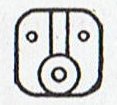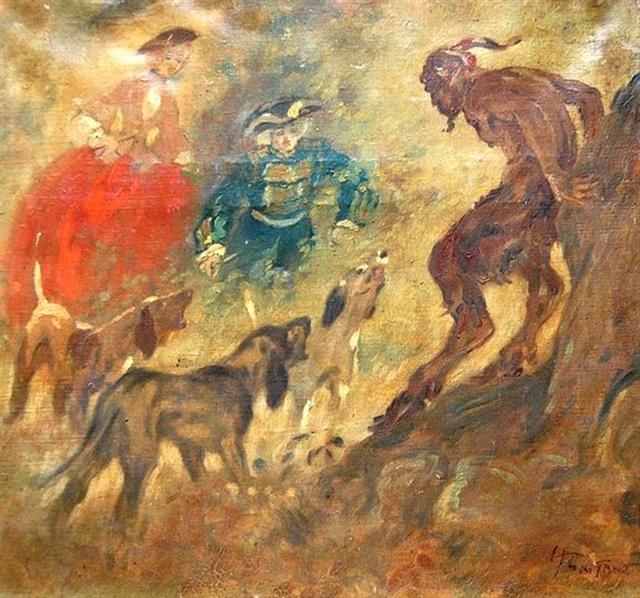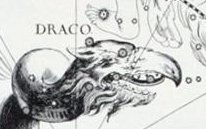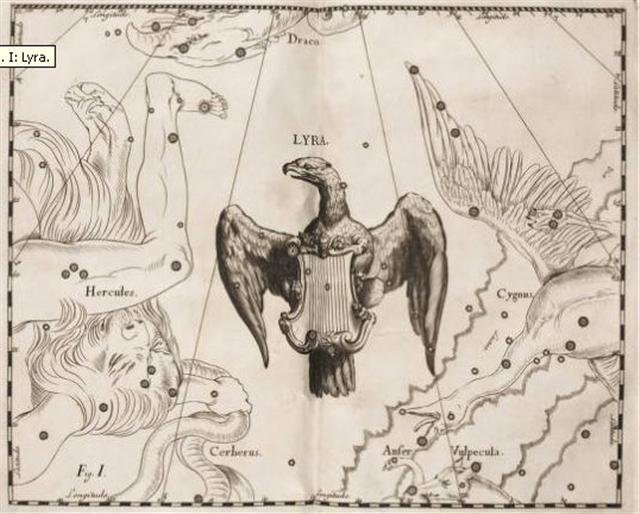In her statement regarding the meaning of
Taku-rua Makemson avoided to
explicitly connect Taku-rua with Jupiter and Venus:
... At the risk
of invoking the criticism, 'Astronomers rush in where
philologists fear to tread', I should like to suggest that
Taku-rua corresponds with the two-headed Roman god
Janus who, on the first of January, looks back upon the old
year with one head and forward to the new year with the
other, and who is god of the threshold of the home as well
as of the year ... There is probably a play on words in
takurua - it has been said that Polynesian phrases
usually invoke a double meaning, a common and an esoteric
one. Taku means 'slow', the 'back' of anything, 'rim'
and 'command'. Rua is a 'pit', 'two' or 'double'.
Hence takurua has been translated 'double command',
'double rim', and 'rim of the pit', by different
authorities. Taku-pae is the Maori word for
'threshold' ... Several Tuamotuan and Society Islands planet
names begin with the word Takurua or Ta'urua
which Henry translated Great Festivity and which is the name
for the bright star Sirius in both New Zealand and
Hawaii. The planet names, therefore, represent the final
stage in the evolution of takurua which was probably
first applied to the winter solstice, then to Sirius which
is the most conspicious object in the evening sky of
December and January, and was then finally employed for the
brilliant and conspicious planets which outshone even the
brightest star Sirius. From its association with the
ceremonies of the new year and the winter solstice,
takurua also aquired the meaning 'holiday' or
'festivity' ...
However, the position of nakshatra Ko Koró
9 at Ga2-27 (probably signifying 22 / 7) was 263 days after 0h and such a period of
time could allude (or even refer) to a time when Venus was
visible:
|
evening star |
263 |
|
black |
8 |
|
morning star |
263 |
|
black |
50 |
|
sum |
584 |
|
8 MAY (*48) |
9 |
10 (130) |
11 |
12 |
13 |
|
*MAY 10 |
11 |
12 (*52) |
13 |
14 |
15 (135) |
|
MAY 14 (*54) |
15 |
16 (136) |
17 |
18 |
19 |
 |
 |
 |
 |
 |
 |
|
Ga2-24 |
Ga2-25 |
Ga2-26 |
Ga2-27 |
Ga2-28 |
Ga2-29 (59) |
|
φ Gemini
(118.4) |
DRUS
= χ Carinae (119.9) |
ω Cancri (120.2) |
8h (121.7)
χ Gemini
(121.0),
NAOS = ζ Puppis
(121.3) |
ρ Puppis (122.0),
HEAP OF FUEL
= μ Cancri (122.1), ζ
Monocerotis (122.3), ψ
Cancri (122.6),
REGOR (Roger reversed)
= γ Velorum (122.7) |
TEGMINE (Covered Up) = ζ
Cancri
(123.3) |
|
July 17 |
18 |
19 (200) |
20 (*121) |
21 |
22 / 7 |
|
"June 6 (157) |
7 |
Kaulua 3 |
9 (*80) |
Maro 10 |
11 |
|
ι Sagittarii (301.2),
TEREBELLUM = ω
Sagittarii, ξ Aquilae
(301.3),
ALSHAIN (Falcon)
= β Aquilae (301.6), φ
Aquilae (301.8) |
ε Pavonis, θ Sagittarii
(302.3), γ Sagittae (302.5),
μ Pavonis (302.7) |
τ Aquilae (303.8) |
20h (304.4)
η Sagittae (304.2), δ
Pavonis (304.4) |
SHANG WEI (Higher Guard)
= κ Cephei (305.2), θ
Sagittae (305.4),
TSEEN FOO (Heavenly Raft) =
θ Aquilae (Ant.) (305.6), ξ
Capricorni (305.8) |
TSO
KE (Left Flag) =
ρ Aquilae (306.3) |
|
January 16 |
17 |
18 (383) |
19 (13 * 29½ + ½) |
20 |
21 |
|
"December 6 |
7 (9 * 29) |
8 |
Ko Koró
9 (*263) |
10 |
11 |
|
NOVEMBER 13 |
14 |
15 |
16 (320) |
17 |
18 (*242) |
|
*NOVEMBER 9 |
10 (314) |
11 |
12 (*236) |
13 |
14 |
|
7 NOVEMBER |
8 |
9 |
10 (314) |
11 |
12 (*236) |
Although the Mayas had adopted another view
for their calendar,
by for instance making use of 236 days (= 8 * 29½) as the morning star period
of Venus:
|
phase |
observed periods |
periods in the Mayan 'map' |
difference |
|
evening star |
263 |
250 |
- 13 |
|
black |
8 |
8 |
0 |
|
morning star |
263 |
236 |
- 27 |
|
black |
50 |
90 |
+ 40 |
|
sum |
584 |
584 |
0 |
 |
 |
|
Gb1-6 |
Gb1-7 (236) |
|
TARAZED |
ALTAIR (*300) |

If the periods of Venus were documented in
the rongorongo texts, then the rest of the planets could
easily follow her lead - excepting Mars and Saturn who
formed a special and contrasting pair:
|
Synodic
cycles of the
planets: |
|
Mercury |
115.88 |
= 584
- 468 |
|
Venus |
583.92 |
584 |
|
Sun |
354 |
= 584
- 230 |
|
Mars |
779.96 |
= 10 *
78 |
|
Jupiter |
398.88 |
= 584
- 185 |
|
Saturn |
378.09 |
= 300 +
78 |
|
Uranus |
369.66 |
= 584
- 214 |

The cycle of Jupiter (Father Light, the
Tree), could be defined as 185 days
less than the cycle of Venus, and with October 22 being day 295 (10 *
29½) there was reason to put Jupiter (in the C text) at glyph 398
(as in 398.88, leaving the fraction to the zero position
before Ca1-1), with a complex
illustration explaining how his central position was like a
splendid
isolated Tree (rakau):
 |
|
rakau |
|
Rakau
Raau, medicine, remedy, drug.
Ra'a'u, scratch on the skin. Rakau, a
plant. Râkau, goods, property. Vanaga.
1. Wood; rakau ta, cudgel,
stick. P Pau.: rakau, tree, to dress a wound.
Mgv.: rakau, wood, timber, a tree; medicine,
a remedy; an object. Mq.: ákau, wood, tree.
Ta.: raáu, id. 2. Medicine, remedy, potion,
ointment, furniture, any precious object, resources,
baggage, riches, heritage, dowry, merchandise,
treasure, wealth; rakau hakaneinei,
purgative; rakau nui, rich, opulent; rakau
kore, poor, beggar, indigent, miserable, an
inferior; hakakamikami ki te rakau, to
impoverish; rakau o te miro, ballast. Mq.:
akau, anything in general. The medicine sense is
particularized in Tonga, Nukuoro, Hawaii, Tahiti,
Mangareva, Paumotu. In no other speech does wood
stand so fully for wealth of possessions, but it
will be recalled that Rapanui is destitute of
timber and depends wholly upon driftwood. Churchill. |
 |
 |
 |
rutua - te pahu - rutua te maeva -
atua rerorero - atua hiko ura - hiko o tea - ka higa
te ao ko te henua ra ma te hoi atua |
|
Cb1-5 |
Cb1-6
(398) |
Cb1-7 |
|
April 21
(111) |
22 (*32
= *398 - 366) |
23 (*399
= *33 + 366) |
|
'March 25 (84) |
26 |
27 (*372
= *6 + 366) |
|
η Arietis (31.9) |
no star listed (32) |
θ Arietis (33.3),
MIRA
(33.7) |
|
Neck-2
(Dragon)
Asellus Tertius,
κ VIRGINIS,
14 Bootis (214.8) |
Al
Ghafr-13 /
Svāti-15
TAHUA-TAATA-METUA-TE-TUPU-MAVAE
15
Bootis (215.2),
ARCTURUS
(215.4), Asellus Secundus (215.5), Syrma, λ Bootis
(215.6), η Apodis (215.8) |
ι Lupi,
18 Bootis (216.3), Khambalia (216.4), υ Virginis
(216.5), ψ Centauri (216.6), ε Apodis (216.8) |
|
October
21 (*214) |
22 (295) |
23 |
|
'September 24 (*187) |
25 (268) |
26 |
| |
 |
 |
 |
 |
|
Cb1-8
(400) |
Cb1-9 |
Cb1-10 |
Cb1-11 (403) |
|
April 24
(*400) |
25 |
26 (116) |
27 |
|
'March
28 |
29 |
30 |
31 (90) |
|
no star listed (34) |
ξ Arietis (35.0) |
no star listed (36) |
no star listed (37) |
|
Asellus
Primus (217.8) |
τ Lupi
(218.1), φ Virginis (218.7)
Fomalhaut
|
σ Lupi
(219.1), ρ Bootis (219.5), Haris (219.7) |
σ Bootis
(220.2), η Centauri (220.4) |
|
October
24 |
25 |
26 |
27 (300) |
|
'September 27 |
28 |
29 |
30 (273) |
And evidently Arcturus could have represented the Babylonian
Enlil:
|
33
Northern stars on
the Path of Enlil |
|
Plough |
Enlil,
the lead star of the
stars of Enlil (Most
of Draco) |
1 |
|
Wolf
|
At the seed
funnel of the Plough
(Head & middle of
Draco) |
2 |
|
Old Man |
Enmesharra
(Perseus) |
3 |
|
Crook |
The Crouching god
(Auriga) |
4 |
|
Great Twins |
Lugalirra
and Meslamtaea
(Gemini) |
5-6 |
|
Little Twins |
Alammush
and Ninezengud
(Canis Minor) |
7-8 |
|
Crab |
The seat of
Anu (Cancer) |
9 |
|
Lion |
Latarak
(Leo) |
10 |
|
King Star |
The stars that
stands in the breast
of the Lion (The
star Regulus in Leo) |
11 |
|
Frond of Erua |
The dusky stars
that stand in the
tail of the Lion,
Zarpanitu (Coma
Berenices & the
western part of
Virgo) |
12 |
|
Shupa |
Enlil, who
decrees the fate of
the land (Bootes) |
13 |
|
Star of Abundance |
The star before
him, the messenger
of Ninlil (A
star in the western
part part of Bootes) |
14 |
|
Star of Dignity |
The star behind
him, the messenger
of Tishpak (A
star in the eastern
part of Bootes) |
15 |
|
Wagon |
Ninlil (The
7 principle stars of
Ursa Major) |
16 |
|
Fox |
The star at the
shaft of the Wagon,
the Fox, Erra,
the strong one among
the gods (The star
Zeta in Ursa Major) |
17 |

Finally, as to the
description in the G text of the Creation in August 13, 3114
B.C.;
|
Defeat of
Seven Macaw |
May 28, 3149 B.C. |
12.18.4.5.0
1 Ahaw 3 K'ank'in |
|
Birth
of First Father |
June
16, 3122 B.C. |
12.19.11.13.0 1 Ahaw 8 Muwan |
|
Birth
of First Mother |
December 7, 3121 B.C. |
12.19.13.4.0
8 Ahaw 18 Tz'ek |
|
Creation |
August
13, 3114 B.C. |
4 Ahaw 8
Kumk'u |
|
Ahau. To blow freshly, coolness, zephyr, salubrious, breeze, wind;
ahau ora, agreeable breeze. Hau, to blow,
blusterous, to breathe. |

hau ia
Ba2-11 |

Ahau (Ahaw) |
we should look in
the days after the September (southern spring) equinox:
|
JULY
19 (200) |
20
(*121 = *185 - *64) |
 |
 |
|
Ga5-10 (120) |
Ga5-11 |
|
PÁLIDA
(Pale)
= δ Crucis (184.6),
MEGREZ
(Root of the Tail)
= δ Ursae Majoris (184.9) |
Hasta-13 /
Chariot-28 (Worm)
GIENAH (Wing) = γ Corvi
(185.1), ε Muscae (185.2), ζ Crucis (185.4),
ZANIAH
(Corner)
= η Virginis (185.9) |
|
September 21 (*184) |
EQUINOX |
|
"August 11 (*143) |
12
(224 = 265 - 41) |
|
Uttara Bhādrapadā-27
/ Wall-14 (Porcupine)
ο Oct. (1.3),
ALGENIB PEGASI = γ
Pegasi (1.8) |
χ Pegasi (2.1), θ
Andromedae (2.7) |
|
March 22 (81) |
23 |
|
"February 9 |
10
(41) |
|
JANUARY 17 |
18 (= 82 - 64) |
... On
February 9 the Chorti Ah K'in, 'diviners', begin
the agricultural year. Both the 260-day cycle and the
solar year are used in setting dates for religious and
agricultural ceremonies, especially when those rituals
fall at the same time in both calendars.
The
ceremony begins when the diviners go to a sacred spring
where they choose five stones with the proper shape and
color. These stones will mark the five positions of the
sacred cosmogram created by the ritual. When the stones
are brought back to the ceremonial house, two diviners
start the ritual by placing the stones on a table in a
careful pattern that reproduces the schematic of the
universe. At the same time, helpers under the table
replace last year's diagram with the new one. They
believe that by placing the cosmic diagram under the
base of God at the center of the world they demonstrate
that God dominates the universe.
The priests
place the stones in a very particular order. First the
stone that corresponds to the sun in the eastern,
sunrise position of summer solstice is set down; then
the stone corresponding to the western, sunset position
of the same solstice. This is followed by stones
representing the western, sunset position of the winter
solstice, then its eastern, sunrise position. Together
these four stones form a square. They sit at the four
corners of the square just as we saw in the Creation
story from the Classic period and in the
Popol Vuh.
Finally, the center stone is placed to form the ancient
five-point sign modern researchers called the quincunx
...
|
15 JULY |
16 |
17
(*118) |
18 |
19 (200) |
|
*JULY 17
(*118) |
18 |
19 (200) |
20 |
21 |
|
JULY 21 |
7-22
(*123) |
23 (204
= 268 - 64) |
24 |
25 |
 |
 |
 |
 |
 |
|
Ga5-12 |
(513 =
19 * 27) |
Ga5-14
(124) |
Ga5-15 |
Ga5-16 |
|
CHANG
SHA (Long Sand-bank)
= ζ Corvi (186.3) |
INTROMETIDA
= ε Crucis (187.4),
ACRUX
= α Crucis
(187.5) |
γ COM.
BERENICIS (188.0),
σ Centauri (188.1),
ALGORAB
= δ Corvi (188.5),
GACRUX
= γ Crucis (188.7) |
γ Muscae
(189.0),
AVIS
SATYRA
= η Corvi (189.3), ASTERION
(Starry)
= β Canum Ven. (189.5),
KRAZ
= β Corvi, κ Draconis (189.7) |
α MUSCAE
(190.2),
τ Centauri (190.5), χ Virginis (190.7)
ALDERAMIN
(α Cephei)
|
|
September 23 |
24
(*187) |
25 (268) |
26 |
27 |
|
°September 19 |
20
(*183) |
21 (264) |
EQUINOX |
23 |
|
'August
27 |
28 (240) |
29
(*161) |
30 |
31 |
|
"August
13 |
14
(*146) |
15 (227) |
16 |
17 |
|
σ Andromedae (3.0), ι
Ceti (3.3), ζ Tucanae (3.5), ρ Andromedae, π Tucanae
(3.7) |
no star listed (4) |
ANKAA = α Phoenicis, κ
Phoenicis (5.0)
ALPHARD (α
Hydrae)
|
λ Phoenicis (6.3), β
Tucanae (6.4) |
ANDROMEDA GALAXY (M31),
π Andromedae (7.7) |
|
March 24 |
25 (84) |
26 |
27 |
28 |
|
"February 11 |
12 (408) |
13
(*329) |
14 (45) |
15 (411
= 46 + 365) |
|
JANUARY
19 |
20 (84 -
64) |
21 |
22 (45 -
23) |
23 (388
= 411 - 23) |

|
20 JULY
(201) |
21 |
22 (22 /
7) |
23 |
24
(*125) |
|
*JULY 22
(22 / 7) |
23 |
24
(*125) |
25 |
26 |
|
JULY 26 |
27 |
28 |
29 (210) |
30
(*131) |
 |
 |
 |
 |
 |
|
Ga5-17 |
Ga5-18 (128) |
Ga5-19 |
Ga5-20 |
Ga5-21 |
|
Al
Áwwā'-11 /
Shur-mahrū-shirū-18 (Front or West Shur)
Sombrero Galaxy = M104 Virginis (191.1), ρ Virginis
(191.4),
PORRIMA
= γ Virginis,
γ Centauri (191.5) |
ι Crucis
(192.2), β Muscae (192.5),
MIMOSA
= β Crucis (192.9) |
no star
listed (193) |
κ Crucis
(194.4), ψ Virginis (194.5), μ Crucis, λ Crucis
(194.6),
ALIOTH
(Fat Taíl)
= ε
Ursae Majoris, ι Oct. (194.8) |
MINELAUVA
= δ Virginis (195.1),
COR
CAROLI = α Canum Ven.
(195.3) |
|
September 28 |
29
(*192) |
30 (273) |
October
1 |
2 |
|
°September 24 |
25 (*188) |
26 |
27 (270) |
28 |
|
'September 1 |
2 (*165) |
3 |
4 |
5 (248) |
|
"August 18 (*150) |
Hora Iti
19 (231) |
20 |
21 |
22 |
|
ε Andromedae (8.2),
DELTA
= δ Andromedae (8.4), SCHEDIR
(Breast) = α Cassiopeiae
(8.6), ζ Andromedae, μ Phoenicis (8.9) |
ξ Phoenicis (9.0), ρ
Tucanae (9.1), DENEB KAITOS
= β Ceti, η Phoenicis (9.4),
AL NITHĀM (String of Pearls) = φ¹ Ceti (9.6) |
ACHIRD
(Woman with Luminous Rays) = η Cassiopeiae (10.7) |
Legs-15
(Wolf)
ν Andromedae (11.0), φ²
Ceti (11.1), ρ Phoenicis (11.2),
η ANDROMEDAE (11.4) |
CIH
(Whip) = γ Cassiopeiae, λ Tucanae (12.4), φ³
Ceti (12.6), μ Andromedae (12.8) |
|
March
29 (*8) |
30 |
31 |
April 1 |
2 (92) |
|
"February 16 |
17 (413) |
18 |
19 (50) |
20
(*336) |
|
JANUARY
24 |
25 (*310) |
26 |
27 (392
= 365 + 27) |
28 |

|
33 Northern stars on the Path
of Enlil |
|
Plough |
Enlil, the lead star of the stars of
Enlil (Most of Draco) |
1 |
|
Wolf |
At the seed funnel of the Plough (Head & middle
of Draco) |
2 |
|
Old Man |
Enmesharra
(Perseus) |
3 |
|
Crook |
The Crouching god
(Auriga) |
4 |
|
Great Twins |
Lugalirra
and Meslamtaea (Gemini) |
5-6 |
|
Little Twins |
Alammush
and Ninezengud
(Canis Minor) |
7-8 |
|
Crab |
The seat of Anu (Cancer) |
9 |
|
Lion |
Latarak
(Leo) |
10 |
|
King Star |
The stars that
stands in the breast
of the Lion (The
star Regulus in Leo) |
11 |
|
Frond of Erua |
The dusky stars
that stand in the
tail of the Lion,
Zarpanitu (Coma
Berenices & the
western part of
Virgo) |
12 |
|
Shupa |
Enlil, who
decrees the fate of
the land (Bootes) |
13 |
From
η Andromedae (11.4) to Enlil (Shupa,
the 13th star on the Northern Path) - probably
defined from heliacal Arcturus (215.4) - there would have been 204 days, and 295
(October 22) - 204 = 91 (= 364 / 4 = 13 weeks):
|
Topknot |
η Andromedae |
11.4 |
April 1 (91) |
|
1 |
Al Sharatain |
Pair of Signs |
β Arietis (Sheratan),
γ (Mesarthim) |
27.4 |
April 17 (107) |
| Musca
Borealis |
35 (Head of the Fly), 39
(Kaffaljidhma), and
41 Arietis (Bharani) |
41.4 |
May 1 (121) |
|
2 |
Al Dabarān |
Follower |
α Tauri (Aldebaran), θ¹, θ²´,
γ (Hyadum I),
δ (Hyadum II), ε (Ain) |
63.4 |
May 23 (143) |
|
3 |
Al Hak'ah |
White Spot |
λ Orionis (Heka),
φ¹, φ² |
83.4 |
June 12 (163) |
|
4 |
Al Han'ah |
Brand |
γ Gemini (Alhena), μ (Tejat Posterior),
ν,
η (Tejat Prior),
ξ (Alzirr) |
93.4 |
June 22 (173) |
|
5 |
Al Dhirā' |
Forearm |
α Gemini (Castor),
β (Pollux) |
113.4 |
July 12 (193) |
|
Unicorn |
α Monocerotis |
115.4 |
July 14 (195) |
|
6 |
Al Nathrah |
Gap |
ε Cancri (Beehive) |
130.4 |
July 29 (210) |
|
7 |
Al Tarf |
End |
ξ Cancri,
λ Leonis (Alterf) |
143.4 |
Aug 11 (223) |
|
8 |
Al Jabhah |
Forehead |
η Leonis (Al Jabhah),
α (Regulus), ζ (Adhafera), γ (Algieba) |
152.4 |
Aug 20 (232) |
|
9 |
Al Zubrah |
Mane |
δ Leonis (Zosma),
θ (Coxa) |
169.4 |
Sept 6 (249) |

 |
 |
 |
rutua - te pahu -
rutua te maeva - atua rerorero - atua
hiko ura - hiko o tea - ka higa te ao ko
te henua ra ma te hoi atua |
|
Cb1-5 |
Cb1-6 (398) |
Cb1-7 |
|
April 21 (111) |
22 (*32 = *398 - 366) |
23 (*399 = *33 + 366) |
|
'March 25
(84) |
26 |
27 (*372 = *6 + 366) |
|
η Arietis
(31.9) |
no star
listed (32) |
θ Arietis
(33.3),
MIRA
(33.7) |
|
Neck-2 (Dragon)
Asellus Tertius,
κ VIRGINIS,
14 Bootis (214.8) |
Al Ghafr-13 /
Svāti-15
TAHUA-TAATA-METUA-TE-TUPU-MAVAE
15 Bootis (215.2),
ARCTURUS
(215.4), Asellus Secundus (215.5),
Syrma, λ Bootis (215.6), η Apodis
(215.8) |
ι Lupi, 18 Bootis (216.3), Khambalia
(216.4), υ Virginis (216.5), ψ Centauri
(216.6), ε Apodis (216.8) |
|
October 21 (*214) |
22 (295) |
23 |
|
'September 24 (*187) |
25 (268) |
26 |
|
|
 |
 |
 |
 |
|
Cb1-8 (400) |
Cb1-9 |
Cb1-10 |
Cb1-11 (403) |
|
April 24 (*400) |
25 |
26 (116) |
27 |
|
'March 28 |
29 |
30 |
31 (90) |
|
no star
listed (34) |
ξ Arietis
(35.0) |
no star
listed (36) |
no star
listed (37) |
|
Asellus Primus (217.8) |
τ Lupi (218.1), φ Virginis (218.7)
Fomalhaut
|
σ Lupi (219.1), ρ Bootis (219.5), Haris
(219.7) |
σ Bootis (220.2), η Centauri (220.4) |
|
October 24 |
25 |
26 |
27 (300) |
|
'September 27 |
28 |
29 |
30 (273) |

...
Mons Maenalus, at the feet of Boötes, was
formed by Hevelius, and published in his
Firmamentum Sobiescianum; this title
coinciding with those of neighboring stellar
groups bearing Arcadian names. It is sometimes,
although incorrectly, given as Mons Menelaus,
- perhaps, as Smyth suggested, after the
Alexandrian astronomer referred to by Ptolemy
and Plutarch. The Germans know it as the Berg
Menalus; and the Italians as Menalo.
Landseer has a striking representation of the
Husbandsman, as he styles Boötes, with sickle
and staff, standing on this constellation
figure. A possible explanation of its origin may
be found in what Hewitt writes in his Essays
on the Ruling Races of Prehistoric Times:
The
Sun-god thence climbed up the mother-mountain of
the Kushika race as the constellation Hercules,
who is depicted in the old traditional pictorial
astronomy as climbing painfully up the hill to
reach the constellation of the Tortoise, now
called Lyra, and thus attain the polar star
Vega, which was the polar star from 10000 to
8000 B.C.
May
not this modern companion constellation, Mons
Maenalus, be from a recollection of this early
Hindu conception of our Hercules transferred to
the adjacent Bootes?


|






















